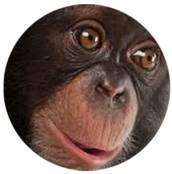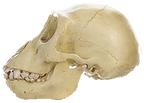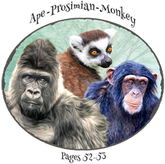Science of Ape Genome
Scientists state that humans and apes share a common ancestor.
God made the animals. He made man in his image. God brought the animals/birds... to Adam so he could name them.
(Genesis 1:24-27, 2:19-20).
It is important to note that God’s purpose in parading all the animals before Adam was not merely so that he would give them names.
It was also to reinforce the fact that he was different in kind from the rest of creation, so that none of these
animals could ever serve as a physical, emotional, intellectual or spiritual companion. (Andrew Kulikovsky)
God made the animals. He made man in his image. God brought the animals/birds... to Adam so he could name them.
(Genesis 1:24-27, 2:19-20).
It is important to note that God’s purpose in parading all the animals before Adam was not merely so that he would give them names.
It was also to reinforce the fact that he was different in kind from the rest of creation, so that none of these
animals could ever serve as a physical, emotional, intellectual or spiritual companion. (Andrew Kulikovsky)
Blood Groups• Humans have blood groups A, B, AB, or O
• Chimps have blood group A, minimal O, never B • Bonobos ONLY have blood group A • Gorillas have blood group B, minimal O, never A • Orangutans have blood groups A, B, AB or O The AB blood group is entirely missing from chimpanzees and bonobos who supposedly are our closest cousins. Although all blood is made of the same basic elements, not all blood is alike. Blood types are determined also by the presence or absence of certain antigens – substances that can trigger an immune response if they are foreign to the body. Since some antigens can trigger a patient’s immune system to attack the transfused blood, safe blood transfusions depend on careful blood typing and cross-matching. In addition to A and B antigens, there is a third antigen called the Rh factor, which can be either present or absent. In general, Rh negative blood is given to Rh negative patients, and Rh positive blood or Rh negative blood may be given to Rh positive patients. (Red Cross) Ape blood is neither identical to nor interchangeable with human blood. Antigens on the surface of red blood cells are different in humans and apes and will be recognized by the immune system as being foreign. DNA“If humans and chimpanzees are over 90-98% identical (reports differ), how do you make sense of the fact that chimpanzees have 10% more DNA than humans? That they have more alpha-hemoglobin genes and more Rh bloodgroup genes, and fewer Alu repeats, in their genome than humans? Or that the tips of their chromosomes contain DNA not present at the tips of human chromosomes? Obviously there is a lot more to genomics than just nucleotide substitution. But the percentage comparison renders that fact invisible, and thus obscures some of the most interesting genetic questions.”
A more recent study found only 86.7% genetic similarity when segments of human and chimpanzee DNA (totaling 1,870,955 base pairs) were laid side by side. This study also included indels (insertions/deletions) in addition to substitutions. (ref: Tatsuya Anzai st al., “Comparative Sequencing of Human and Chimpanzee MHC Class | Regions Unveils Insertions/Deletions As the Major Path to Genomic Divergence,” Proceedings of the National Academy of Sciences, USA 100 (2003); 7708-13) 80% of the proteins in the human and chimpanzee genomes are different. This comparison is very significant because proteins are ultimately responsible for an organism’s anatomical, physiological, and behavioral characteristics. Therefore, a high degree of genetic similarity doesn’t necessarily mean that humans and chimpanzees are closely related organisms. (ref: Galina Glazko, Vamsi Veeramachaneni, Masatoshi Nei and Wojciech Makalowski, “Eighty Percent of Proteins are Different between Humans and Chimpanzees,” Gene vol. 346 14 Feb. 2005, pgs. 215-219) DigestiveChimps have a much bigger large intestine than humans do which is better for the chimps' low-quality, high-fiber diet of fruits, stem, and leaves to be digested (fermented by gut bacteria) for a longer period of time. Humans have a larger small intestine, which is where a lot of nutrients are absorbed from high-quality, low-fiber foods.
1 Corinthians 15:39-41
|
TransplantsBiological (tissue) valves are taken from pig, cow, or human donors. The pigs genetic makeup is pretty close to humans. -Dr. Samer Mattar. Pig organs are closer to our size. They will not be rejected like the chimpanzees will be. An adult male chimpanzee’s main organs are only about 2/3rds the size of an adult male human’s. When tissue valves are used from a pig, cow or human, long-term use of an anticoagulant often isn’t needed.
The DNA of a child will only have 94% of it’s parents DNA. There’s a 6% difference! But yet an organ transplant can be done between them. But not with the chimpanzee, that supposedly, is a closer match to humans than even the human offspring (according to science). In most animals, the surface of every cell, except brain cells, carry glycoproteins that contain one particular member of a family of sugar molecules called sialic acid. In humans, a genetic mutation means this sugar is not present in any cell in the body. Proteins and membrane lipids that have sialic acid take part in many processes. They help cells stick to one another. They may also play a part in disease susceptibility. This might be a reason why Chimpanzees seem far less susceptible for infectious diseases like malaria and cholera. This might be one factor in those chimp to human transplants in which organs were rejected.” Physical DifferencesBody Hair - Humans nearly hairless. Hair on head and face continues to grow and needs to be cut. Chimp fur never needs a haircut. No need to shave a beard.
Breath - We can hold ours, chimps can’t. Genes - A human male’s genes are closer to a chimpanzee than to the female of his own species. On the other hand, the number of genetic differences between a human and a chimp is about 10 times more than between any two humans. Height/Weight - Chimp Male: 3-4´, 75-155#; Female: 2-3.5´, 57-110#. Intelligence - Chimps’ intelligence is that of a 16 month old child. A human brain is 3.6 times larger than a chimps. Lips - Chimps have prehensile tongues, humans do not. Speech - Chimps grunt even though they share the frontal lobe region called Broca’s area. Humans’ broca area is 6 times larger. Strength - Chimps have 5 times the upper body strength than a human. Walking - Chimps are still knuckle walking. Humans walk upright on two legs (bipedal). Knuckle walking to bipedal results in: Inner ear bones, rib cage and feet restructured, spinal cord opening relocated, more spinal curvature, body muscular changed, pelvis reshaped, lower limbs altered and enlarged joint surfaces. Misc. - Humans don’t have tails. Chimps rarely have whites (sclera) in their eyes. Our nose protrudes. Feet - The structual changes to the feet are not simple in that they involve an elaborate plantar aponeurosis, strong plantar ligaments, longitudinal arches, an enlarged musculus flexor accessories, a remolded calcaneocuboid joint, a long tarsus, reorganization of the neuronal innervation and blood vascularization, an adducted (non-opposable) hallux and shortened toes. Many are quick to point out that primates needed to possess opposable digits so they could grasp, and quickly swing from tree branches. But then, how about the feet, did they devolve, humans have the opposable thumb, but not the opposable big toe? Animals that have opposable thumbs: • Apes; Bonobo, Chimpanzee, Gorilla and Orangutan • Birds (most) have at least one opposable digit on the foot, in various configurations, but these are seldom called “thumbs” • Giant Pandas - five clawed fingers plus an extra-long sesamoid bone that, though not really a finger (as the human thumb is), works like an opposable thumb • Gibbons - on both hands & feet • Koalas, Lemurs, Lorises, and the Aye-Aye • Lophiomys - a genus of african rodent • Opossums - opposable “thumbs” on the rear feet • Phyllomedusa - a genus of frogs native to South America • Possums (Phalangerid marsupials) - an opposable toe on each foot, plus two opposable digits on each hand • Polydactyl cats - when a cat has six toes, both the innermost and outermost toes may become opposable |




